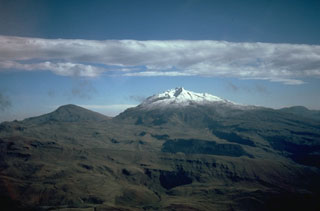Report on Chiles-Cerro Negro (Colombia-Ecuador) — 8 March-14 March 2023
Smithsonian Institution / US Geological Survey
Weekly Volcanic Activity Report, 8 March-14 March 2023
Managing Editor: Sally Sennert.
Please cite this report as:
Global Volcanism Program, 2023. Report on Chiles-Cerro Negro (Colombia-Ecuador) (Sennert, S, ed.). Weekly Volcanic Activity Report, 8 March-14 March 2023. Smithsonian Institution and US Geological Survey.
Chiles-Cerro Negro
Colombia-Ecuador
0.817°N, 77.938°W; summit elev. 4698 m
All times are local (unless otherwise noted)
A seismic swarm at the Cerro Negro de Mayasquer and Chiles volcanoes, called the Chiles-Cerro Negro volcanic complex (CCNVC), began on 9 March according to the Instituto Geofísico de la Escuela Politécnica Nacional (IGEPN) and the Observatorio Vulcanológico de Pasto (OVP-Colombia). A noted increase in the intensity of seismic signals occurred at 0430 and was followed by an increase in the number of volcano-tectonic events (indicating fracturing rock) at 0900. By 1630, there were around 2,200 earthquakes recorded by the seismic network, and 520 of those events had epicenters located within 2.5 km S of Chiles at depths of 1-6 km below the summit (4,700 m elevation). The swarm was accompanied by deformation which was first detected on 28 February. The swarm intensified during 9-10 March, and 86 earthquakes were above M2. At 2010 on 9 March a M 3.4 earthquake was felt by residents in nearby towns in both Colombia and Ecuador; earthquakes recorded at 0137 and 0526 on 10 March were also felt. On 10 March earthquakes were occurring at a rate of around 200 events per hour and were mostly comprised of volcano-tectonic events (indicating fracturing rock) and very-low-frequency earthquakes (indicating fluid movement). At least 4,500 events had been recorded by 1214 on 10 March. There were 4,244-4,915 daily earthquakes during 11-13 March. The Alert Level remained at 3 (Yellow; the second lowest level on a four-color scale).
Geological Summary. The Chiles-Cerro Negro volcanic complex includes both the Pleistocene Chiles and the Cerro Negro de Mayasquer stratovolcanoes astride the Colombia-Ecuador border. Cerro Negro has a caldera open to the west, with andesitic and dacitic lava flows of possible Holocene age (Hall 1992, pers. comm.) and solfataras on the shore of a small crater lake. An eruption reported in 1936 may have been from Reventador (Catalog of Active Volcanoes of the World). The higher, glacier-covered summit of Chiles, about 4 km ESE of Cerro Negro, last erupted about 160,000 years ago, but it has a caldera open to the north with hot springs and an active hydrothermal system on its eastern flank.
Sources: Instituto Geofísico-Escuela Politécnica Nacional (IG-EPN), Servicio Geológico Colombiano (SGC)

